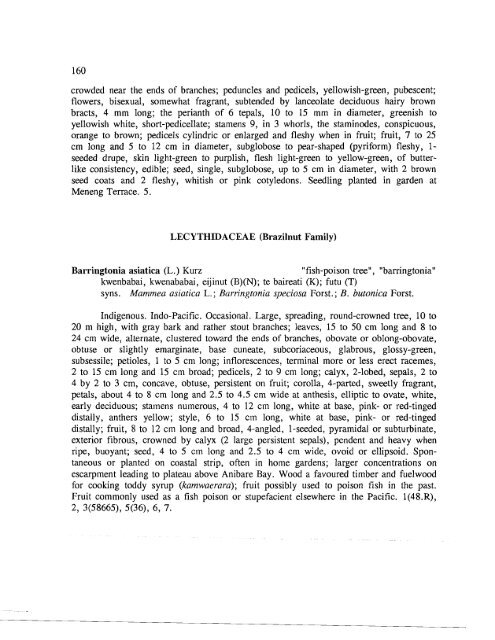atoll research bulletin no. 392 the flora of - Smithsonian Institution ...
atoll research bulletin no. 392 the flora of - Smithsonian Institution ...
atoll research bulletin no. 392 the flora of - Smithsonian Institution ...
Create successful ePaper yourself
Turn your PDF publications into a flip-book with our unique Google optimized e-Paper software.
crowded near <strong>the</strong> ends <strong>of</strong> branches; peduncles and pedicels, yellowish-green, pubescent;<br />
flowers, bisexual, somewhat fragrant, subtended by lanceolate deciduous hairy brown<br />
bracts, 4 mm long; <strong>the</strong> perianth <strong>of</strong> 6 tepals, 10 to 15 mm in diameter, greenish to<br />
yellowish white, short-pedicellate; stamens 9, in 3 whorls, <strong>the</strong> stami<strong>no</strong>des, conspicuous,<br />
orange to brown; pedicels cylindric or enlarged and fleshy when in fruit; fruit, 7 to 25<br />
cm long and 5 to 12 cm in diameter, subglobose to pear-shaped (pyriform) fleshy, 1-<br />
seeded drupe, skin light-green to purplish, flesh light-green to yellow-green, <strong>of</strong> butter-<br />
like consistency, edible; seed, single, subglobose, up to 5 cm in diameter, with 2 brown<br />
seed coats and 2 fleshy, whitish or pink cotyledons. Seedling planted in garden at<br />
Meneng Terrace. 5.<br />
LECY THIDACEAE (Brazilnut Family)<br />
Barringtonia asiatica (L.) Kurz "fish-poison tree", "barringtonia"<br />
kwenbabai, kwenababai, eijinut (B)(N); te baireati (K); futu (T)<br />
syns. Mammea asiatica L. ; Barrin.gtnnia speciosa Forst. ; B. butonica Forst.<br />
Indige<strong>no</strong>us. Indo-Pacific. Occasional. Large, spreading, round-crowned tree, 10 to<br />
20 m high, with gray bark and ra<strong>the</strong>r stout branches; leaves, 15 to 50 cm long and 8 to<br />
24 cm wide, alternate, clustered toward <strong>the</strong> ends <strong>of</strong> branches, obovate or oblong-obovate,<br />
obtuse or slightly emarginate, base cuneate, subcoriaceous, glabrous, glossy-green,<br />
subsessile; petioles, 1 to 5 cm long; inflorescences, terminal more or less erect racemes,<br />
2 to 15 cm long and 15 cm broad; pedicels, 2 to 9 cm long; calyx, 2-lobed, sepals, 2 to<br />
4 by 2 to 3 cm, concave, obtuse, persistent on fruit; corolla, 4-parted, sweetly fragrant,<br />
petals, about 4 to 8 cm long and 2.5 to 4.5 cm wide at an<strong>the</strong>sis, elliptic to ovate, white,<br />
early deciduous; stamens numerous, 4 to 12 cm long, white at base, pink- or red-tinged<br />
distally, an<strong>the</strong>rs yellow; style, 6 to 15 cm long, white at base, pink- or red-tinged<br />
distally; fruit, 8 to 12 cm long and broad, 4-angled, l-seeded, pyramidal or subturbinate,<br />
exterior fibrous, crowned by calyx (2 large persistent sepals), pendent and heavy when<br />
ripe, buoyant; seed, 4 to 5 cm long and 2.5 to 4 cm wide, ovoid or ellipsoid. Spontaneous<br />
or planted on coastal strip, <strong>of</strong>ten in home gardens; larger concentrations on<br />
escarpment leading to plateau above Anibare Bay. Wood a favoured timber and fuelwood<br />
for cooking toddy syrup (karn~~c~rara); fruit possibly used to poison fish in <strong>the</strong> past.<br />
Fruit commonly used as a fish poison or stupefacient elsewhere in <strong>the</strong> Pacific. 1(48.R),<br />
2, 3(58665), 5(36), 6, 7.

















